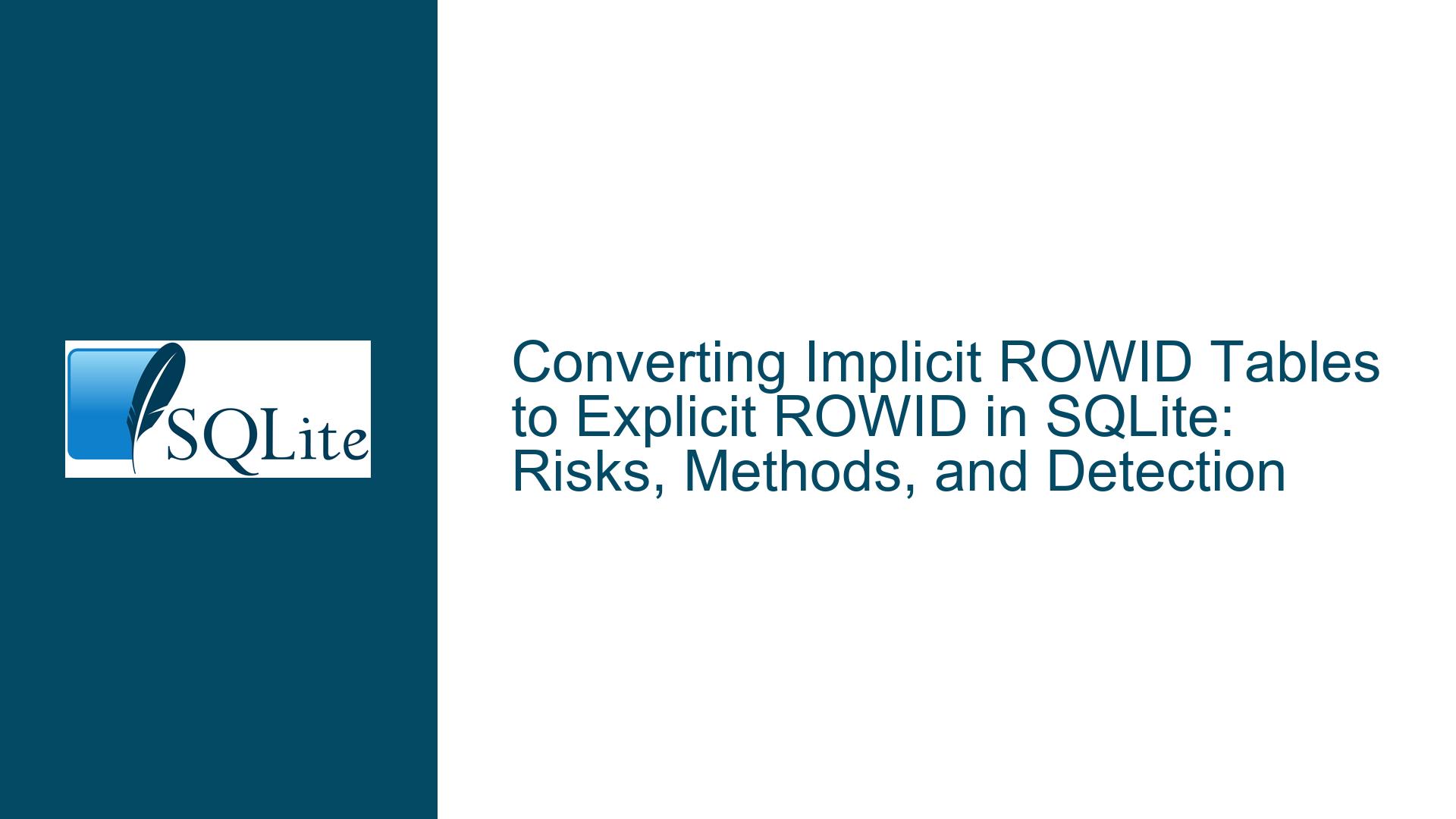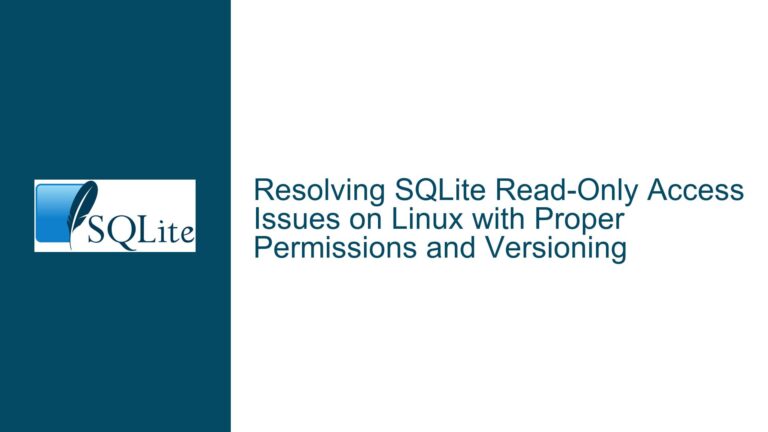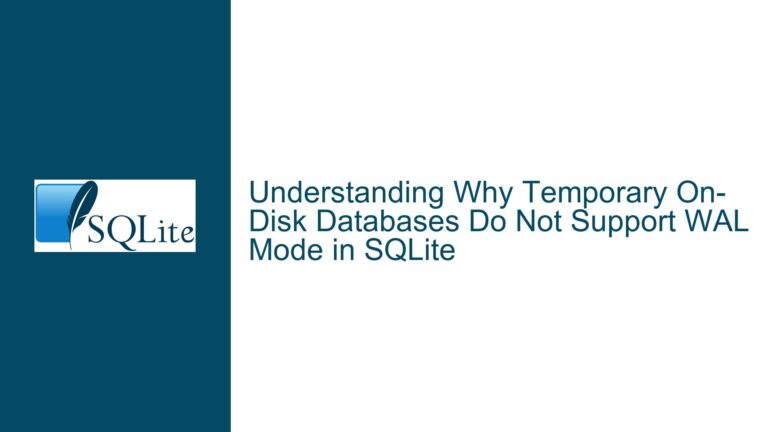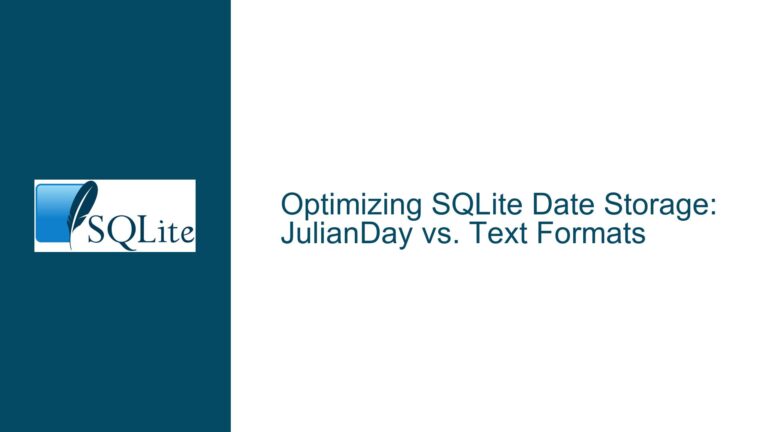Converting Implicit ROWID Tables to Explicit ROWID in SQLite: Risks, Methods, and Detection
Understanding the Core Challenge of ROWID Conversion
The central challenge in this scenario revolves around modifying an existing SQLite table to transition from relying on the implicit ROWID mechanism to using an explicitly defined ROWID column. SQLite automatically assigns a 64-bit signed integer ROWID (or _ROWID_/OID) to every table unless the table is explicitly defined as WITHOUT ROWID. When a column is declared as INTEGER PRIMARY KEY, it becomes an alias for the implicit ROWID, effectively creating an explicit reference to it. However, converting an existing table to use this explicit alias—or eliminating the implicit ROWID entirely—requires careful schema manipulation, data migration, and awareness of SQLite’s internal behaviors.
This process is complicated by three factors:
- Schema Immutability: SQLite does not support
ALTER TABLEto redefine primary keys or convert between rowid andWITHOUT ROWIDtables. - Data Preservation: Migrating data while retaining existing
ROWIDvalues (or aliases) is critical for referential integrity. - Detection Complexity: Programmatically determining whether a table uses an implicit or explicit
ROWIDinvolves parsing schema metadata.
Key Risks and Misconceptions in ROWID Management
1. Implicit vs. Explicit ROWID Ambiguity
A common misconception is that defining an INTEGER PRIMARY KEY column eliminates the implicit ROWID. In reality, this column becomes an alias for the ROWID, but the underlying storage mechanism remains unchanged. The ROWID still exists unless the table is explicitly created as WITHOUT ROWID. This distinction is critical for applications relying on ROWID-specific behaviors, such as AUTOINCREMENT or direct ROWID access.
2. Unsafe Schema Modifications
Directly editing the sqlite_master table (via PRAGMA writable_schema=ON) to redefine a table’s schema bypasses SQLite’s integrity checks. While this might appear to "convert" a table by adding an INTEGER PRIMARY KEY retroactively, it risks:
- Data type mismatches (e.g., non-integer values in the new primary key).
- Index and foreign key corruption due to schema/rowid mismatches.
- Irreversible database corruption if the modified schema is syntactically invalid.
3. Misunderstanding WITHOUT ROWID Implications
Creating a WITHOUT ROWID table changes the storage engine’s behavior: the primary key becomes a covering index, and ROWID ceases to exist. However, converting an existing table to WITHOUT ROWID is not possible without recreating the table, and doing so invalidates any dependencies on ROWID (e.g., INSERT OR REPLACE logic using ROWID).
Comprehensive Strategies for Conversion and Validation
Step 1: Detect the Current ROWID Configuration
Before modifying a table, determine whether it uses an implicit or explicit ROWID. Use the following SQL query to inspect the table’s primary key definition:
SELECT name, type, pk
FROM pragma_table_info('YourTable')
WHERE pk >= 1
ORDER BY pk;
- If a single column of type
INTEGERhaspk=1, the table has an explicitROWIDalias. - If no such column exists, the table uses an implicit
ROWID.
For programmatic detection (e.g., in Python):
import sqlite3
def is_explicit_rowid(db_path, table_name):
conn = sqlite3.connect(db_path)
cursor = conn.cursor()
cursor.execute(f"PRAGMA table_info({table_name})")
columns = cursor.fetchall()
for col in columns:
# col[5] (pk) indicates primary key order
if col[5] == 1 and col[2].upper() == 'INTEGER':
return True
return False
Step 2: Choose a Conversion Method
Method A: Safe Table Recreation (Recommended)
- Create a New Table: Define the explicit
INTEGER PRIMARY KEYcolumn.CREATE TABLE NewTable ( id INTEGER PRIMARY KEY, -- Explicit ROWID alias column1 TEXT, column2 INT ); - Migrate Data: Preserve existing
ROWIDvalues by copying them into the newidcolumn.INSERT INTO NewTable (id, column1, column2) SELECT rowid, column1, column2 FROM OldTable; - Rebuild Dependencies: Recreate indexes, triggers, and foreign keys referencing the old table.
- Replace the Old Table:
DROP TABLE OldTable; ALTER TABLE NewTable RENAME TO OldTable;
Method B: Schema Editing (High Risk)
- Disable Defensive Mechanisms:
PRAGMA writable_schema = ON; PRAGMA ignore_check_constraints = ON; - Update the Schema Definition:
UPDATE sqlite_master SET sql = 'CREATE TABLE YourTable (id INTEGER PRIMARY KEY, column1 TEXT, column2 INT)' WHERE name = 'YourTable'; - Reset and Validate:
PRAGMA writable_schema = RESET; PRAGMA quick_check; -- Verify database integrity
Warnings:
- Backup the database before attempting this.
- Ensure the new schema is syntactically identical except for the added primary key.
- SQLite will not populate the
idcolumn automatically; existing rows will haveid=NULLunless updated manually.
Step 3: Handle WITHOUT ROWID Requirements
If eliminating ROWID entirely is necessary:
- Recreate the Table:
CREATE TABLE NewTable ( id INTEGER PRIMARY KEY, column1 TEXT, column2 INT ) WITHOUT ROWID; - Migrate Data:
INSERT INTO NewTable (id, column1, column2) SELECT rowid, column1, column2 FROM OldTable; - Update Application Logic: Replace all references to
ROWIDwithid.
Step 4: Verify and Test
After conversion:
- Check Schema Integrity:
PRAGMA integrity_check; - Confirm ROWID Behavior:
-- For explicit alias: SELECT id, _ROWID_, column1 FROM YourTable; -- Should return identical values for id and _ROWID_ -- For WITHOUT ROWID: SELECT * FROM YourTable; -- No _ROWID_ column - Test Performance:
WITHOUT ROWIDtables can improve query speed for primary key lookups but may increase storage overhead.
Final Recommendations and Best Practices
- Prefer Safe Recreation: Despite being slower for large tables, this method guarantees data integrity.
- Avoid Writable Schema Edits: The risks of corruption outweigh the convenience.
- Document Schema Changes: Track conversions to resolve future compatibility issues.
- Benchmark Storage Impact:
WITHOUT ROWIDtables use clustered indexes, which may require more disk space.
By methodically addressing detection, conversion, and validation, developers can transition between ROWID configurations while minimizing downtime and data loss.






